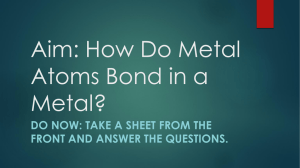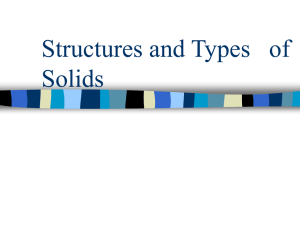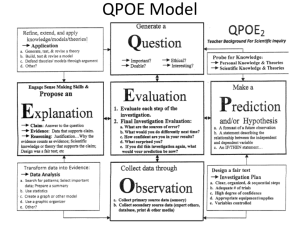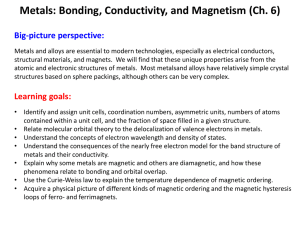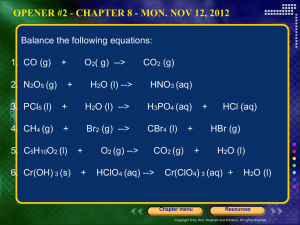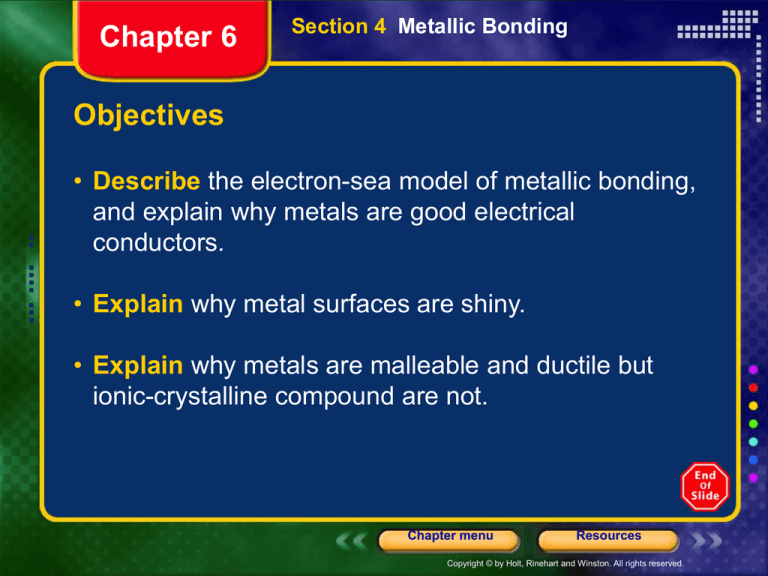
Chapter 6
Section 4 Metallic Bonding
Objectives
• Describe the electron-sea model of metallic bonding,
and explain why metals are good electrical
conductors.
• Explain why metal surfaces are shiny.
• Explain why metals are malleable and ductile but
ionic-crystalline compound are not.
Chapter menu
Resources
Copyright © by Holt, Rinehart and Winston. All rights reserved.
6.4
Bonding in Metals
You have probably seen
decorative fences,
railings, or weathervanes
made of a metal called
wrought iron. In this
section, you will learn
how metallic properties
derive from the way that
metal ions form bonds
with one another.
Slide
of 39
2
© Copyright Pearson Prentice Hall
End Show
Chapter 6
Section 4 Metallic Bonding
The Metallic-Bond Model
• In a metal, the vacant orbitals in the atoms’ outer
energy levels overlap.
• This overlapping of orbitals allows the outer electrons of
the atoms to roam freely throughout the entire metal.
• The electrons are delocalized, which means that they
do not belong to any one atom but move freely about
the metal’s network of empty atomic orbitals.
Chapter menu
Resources
Copyright © by Holt, Rinehart and Winston. All rights reserved.
6.4
Bonding in Metals > Metallic Bonds and Metallic Properties
The valence electrons of metal atoms
can be modeled as a sea of electrons.
The valence electrons are mobile and
can drift freely from one part of the metal
to another.
Metallic bonds consist of the attraction of
the free-floating valence electrons for the
positively charged metal ions.
Slide
of 19
4
© Copyright Pearson Prentice Hall
End Show
Chapter 6
Section 4 Metallic Bonding
The Metallic-Bond Model
• These mobile electrons form a sea of
electrons around the metal atoms, which
are packed together
in a crystal lattice.
• The chemical bonding that results from the
attraction
between metal atoms and the surrounding
sea of
electrons is called metallic bonding.
Chapter menu
Resources
Copyright © by Holt, Rinehart and Winston. All rights reserved.
Chapter 6
Visual Concepts
Metallic Bonding
Click below to watch the Visual Concept.
http://my.hrw.com/sh/hc6_003036809x/stude
Visual Concept
nt/ch06/sec04/vc00/hc606_04_v00fs.htm
Chapter menu
Resources
Copyright © by Holt, Rinehart and Winston. All rights reserved.
6.4
Bonding in Metals > Crystalline Structure of Metals
Crystalline Structure of Metals
How are metal atoms arranged?
Slide
of 19
7
© Copyright Pearson Prentice Hall
End Show
6.4
Bonding in Metals > Crystalline Structure of Metals
These tomatoes have
a closed-packed
arrangement. Similar
arrangements can be
found in the crystalline
structure of metals.
Slide
of 19
8
© Copyright Pearson Prentice Hall
End Show
6.4
Bonding in Metals > Crystalline Structure of Metals
Metal atoms are arranged in very
compact and orderly patterns.
Slide
of 19
9
© Copyright Pearson Prentice Hall
End Show
Chapter 6
Section 4 Metallic Bonding
Metallic Bonding
• Chemical bonding is different in metals than it is in
ionic, molecular, or covalent-network compounds.
• The unique characteristics of metallic bonding gives
metals their characteristic properties, listed below.
• electrical conductivity
• thermal conductivity
• malleability
• ductility
• shiny appearance
Chapter menu
Resources
Copyright © by Holt, Rinehart and Winston. All rights reserved.
Chapter 6
Section 4 Metallic Bonding
Metallic Bonding, continued
• Malleability is the ability of a substance to be
hammered or beaten into thin sheets.
• Ductility is the ability of a substance to be drawn,
pulled, or extruded through a small opening to produce
a wire.
Chapter menu
Resources
Copyright © by Holt, Rinehart and Winston. All rights reserved.
Chapter 6
Visual Concepts
Properties of Metals: Electrical and
Thermal Conductivity
Click below to watch the Visual Concept.
http://my.hrw.com/sh/hc6_003036809x/student/c
Visual Concept
h06/sec04/vc01/hc606_04_v01fs.htm
Chapter menu
Resources
Copyright © by Holt, Rinehart and Winston. All rights reserved.
Chapter 6
Visual Concepts
Properties of Metals: Malleability and
Ductility
Click below to watch the Visual Concept.
http://my.hrw.com/sh/hc6_003036809x/stu
Visual Concept
dent/ch06/sec04/vc03/hc606_04_v03fs.ht
m
Chapter menu
Resources
Copyright © by Holt, Rinehart and Winston. All rights reserved.
Chapter 6
Visual Concepts
Properties of Metals: Surface Appearance
Click below to watch the Visual Concept.
http://my.hrw.com/sh/hc6_003036809x
Visual Concept
/student/ch06/sec04/vc02/hc606_04_v
02fs.htm
Chapter menu
Resources
Copyright © by Holt, Rinehart and Winston. All rights reserved.
Chapter 6
Section 4 Metallic Bonding
Properties of Substances with Metallic, Ionic, and
Covalent Bonds
Chapter menu
Resources
Copyright © by Holt, Rinehart and Winston. All rights reserved.
Metallic Properties
* Metallic bond strength varies with the nuclear charge and the
number of electrons in the metal’s electron sea.
*The enthalpy of vaporization is the amount of energy absorbed
as heat when a specified amount of a substance vaporizes at
constant pressure. This is a measure of the strength of the
metallic bonds.
Chapter menu
Resources
Copyright © by Holt, Rinehart and Winston. All rights reserved.
6.4
Bonding in Metals > Alloys
Alloys
Why are alloys important?
Slide
of 19
17
© Copyright Pearson Prentice Hall
End Show
6.4
Bonding in Metals > Alloys
Alloys are mixtures composed of two or more
elements, at least one of which is a metal.
Alloys are important because their
properties are often superior to those
of their component elements.
Slide
of 19
18
© Copyright Pearson Prentice Hall
End Show
6.4
Bonding in Metals > Alloys
Bicycle frames are often made of titanium alloys
that contain aluminum and vanadium.
Slide
of 19
19
© Copyright Pearson Prentice Hall
End Show
6.4
Bonding in Metals > Alloys
The most important alloys
today are steels. Steels
have a wide range of useful
properties, such as
corrosion resistance,
ductility, hardness, and
toughness.
Slide
of 19
20
© Copyright Pearson Prentice Hall
End Show
6.4 Section Quiz.
Assess students’ understanding of
the concepts in Section
6.4.
Continue to:
-or-
Launch:
Section Quiz
Slide
of 27
© Copyright Pearson Prentice Hall
End Show
6.4 Section Quiz.
1. The valence electrons of metals can be
modeled as
a.
a body-centered cube.
b.
octets of electrons.
c.
a rigid array of electrons.
d.
a sea of electrons.
Slide
of 39
© Copyright Pearson Prentice Hall
End Show
6.4 Section Quiz.
2. In most metals, the atoms are
a. free to move from one part of the metal to
another.
b. arranged in a compact and orderly pattern.
c. placed at irregular locations.
d. randomly distributed.
Slide
of 39
© Copyright Pearson Prentice Hall
End Show
6.4 Section Quiz.
3. Alloys are important because they
a.
are pure substances.
b. are the ores from which metals can be
refined.
c. can have properties superior to those of
their components.
d. are produced by the combustion of metals.
Slide
of 39
© Copyright Pearson Prentice Hall
End Show
Online Self-Check Quiz
Complete the online Quiz and record answers.
Ask if you have any questions about your
answers.
click here for online Quiz 6.4
(7 questions)
You must be in the “Play mode” for the
slideshow for hyperlink to work.
Slide
of 25
© Copyright Pearson Prentice Hall
End Show
Bonding in Metals > Concept Map 7
Concept Map 7 Solve the Concept Map with
the help of an interactive guided tutorial.
Slide
of 19
26
© Copyright Pearson Prentice Hall
End Show
VIDEOS FOR ADDITIONAL INSTRUCTION
Additional Videos for Section 6.4: Metallic Bonding
Metallic Bond (2:30)
Slide
of 28
© Copyright Pearson Prentice Hall
End Show

